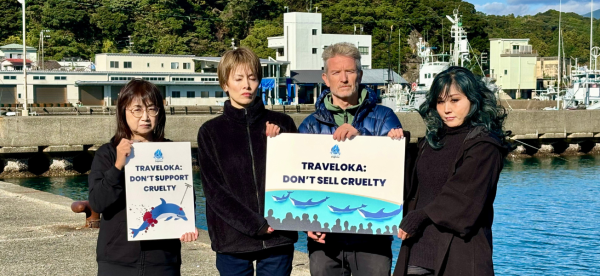After an 8-hour trip from Tokyo, I arrived in Taiji armed with little more than half a dozen sign boards made up for the protest, but after picking up a rental vehicle I noticed a familiar sight through the rearview mirror. I was being tailed by a garden variety white passenger vehicle, with no markings, but whose passengers I knew belonged to a Wakayama Prefectural police surveillance team that monitors the town 24-7.
One of those “passengers” eventually caught up with me and the other protest members the following morning at a well-known tourist spot, Cape Tomyozaki, which protrudes like a jagged spear into the Pacific Ocean on the eastern extreme of the town. Once used by Taiji whalers as a camp and lookout point, this narrow rocky promontory is today populated by five protestors, a hand-holding young couple out on a morning stroll, and an inordinate number of aging information signs, some barely legible due to the elements and years of neglect.
The plain-clothed patroller was soon joined by two officers in uniform, one holding a clipboard, which stayed for the most part tightly clamped under his arm. They are three of around 10 officers dispatched (at the taxpayer’s expense) to the tiny fishing town of Taiji during the hunt season (September-March), ostensibly to keep protesters in line. There have been few demonstrators in recent years (Wakayama police reported 50 during the 2023-24 season, a figure that’s pooh-poohed by resident dolphin hunt documenter, Kunito Seko), meaning they spend much of their time inside the purpose-built “local vigilance station” that overlooks Hatakejiri Bay, aka “The Cove.”
On previous visits these officers of the law have been more brusque, demanding identification and questioning with some verve. On this occasion, however, their approach has softened, their communication style evolved, with questions cloaked in polite chit-chat and light-hearted banter. But they could see the green behind our ears was washed away some time ago, and seemingly content that we did not present a threat to their stated remit (upholding the “safety and security of the town’s residents” and preventing any “illegal sabotage” by groups opposed to the hunts) they left within the hour, though the white vehicle would be spotted again through the rearview mirror of the rental vehicle.
From there we moved on to several venues around the sleepy town of 2,800 residents to hold the protest proper. Among them was the infamous “Cove” where the Taiji dolphin hunters incarcerate their catch and divide them up into those to be sold into captivity and those to be slaughtered for their meat. Today, unlike on virtually all of my previous visits, there are no dolphins swimming in the enclosed area of the tranquil bay behind us. In fact, as we set up for the demo, we are buoyed by the news that the hunting vessels, which we had earlier watched leaving the harbor at the crack of dawn, had returned empty-handed — one more “blue cove” day to be thankful for.

This month our voices echoed across the Taiji cove
Our next port of call was the Taiji Whale Museum, home to dolphin and other cetacean shows and the first place to benefit from the hunts when they were inaugurated, as a commercial enterprise, in 1969 (the first sales to aquariums outside Taiji began in 1970). A few visitors stopped to look at the protest, but none engaged, yet another difference from previous visits when people I have met there have shown an interest in sharing their views on the hunts and the captive trade.
Shortly before the aquarium opened its doors for business and the protest started we had peered through gaps in a fence as trainers used thin tubes to apparently force-feed two dolphins in one of the pools inside the facility. I had witnessed something similar on a previous visit, and approached a trainer for an explanation. She told me the dolphins were often force-fed water to prevent dehydration. However, in an interview with a former Taiji trainer earlier this year, I was told that force-feeding is common in Taiji and elsewhere in Japan, especially when dolphins first enter aquariums and reject the defrosted, inanimate fish they are customarily fed in exchange for the diversion they crave.
I also visited coastal spots within viewing range of a few of the cramped pen compounds dotted along the Taiji coast that are used to keep dolphins destined for captivity in Japan and abroad. While one was clearly home to about half a dozen dolphins, who made occasional jumps to the tune of a fish-toting trainer, a further three appeared to be empty, a sign, perhaps, of an upturn in trade. Or, even more disturbingly, perhaps the result of declining dolphins stocks in the ocean: The former trainer also mentioned that dolphin catch numbers, especially of the Bottlenose variety so prized by aquariums, have been falling in Japan’s waters for several years and that Taiji’s hunters are aware of this.
Whatever the cause, a recent study suggests that Japan’s 130 aquariums are quickly recovering from the fallout of the Corona pandemic. According to an independent report titled “Leisure Lands and Recreational Parks 2024,” Japan’s most popular facility, Okinawa Churaumi Aquarium (home to a dolphin show and contact facility), received 2.16 million visitors in 2022, up 250 percent over the previous year. If there has ever been a time to hold travel companies to account and demand they end ticket sales to aquariums, it’s now. We are planning to build unstoppable pressure on Traveloka and other companies that are complicit in the dolphins’ suffering. Please help us. The dolphins need you more than ever.
